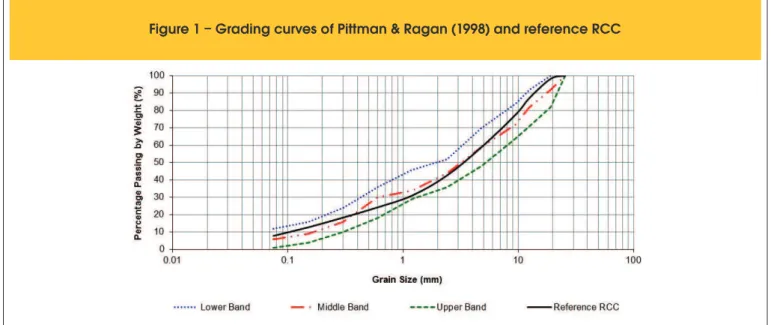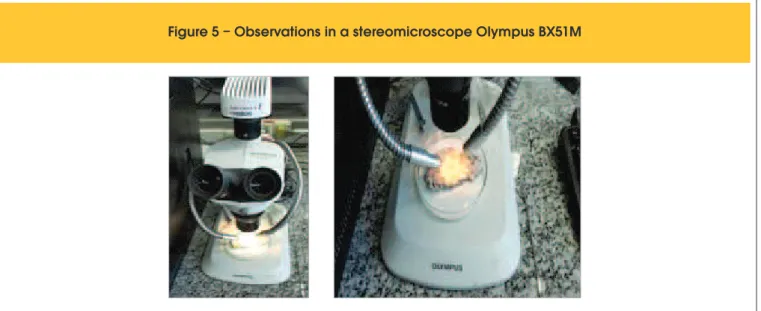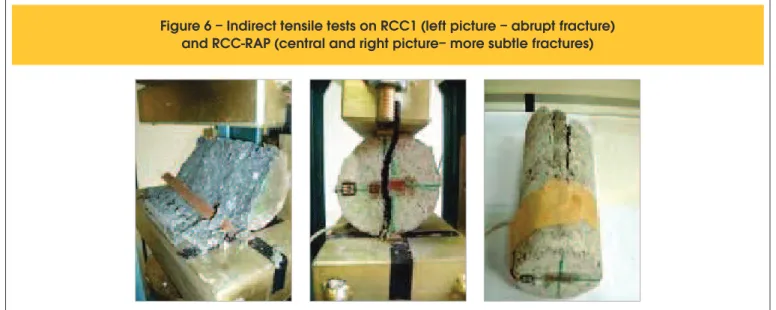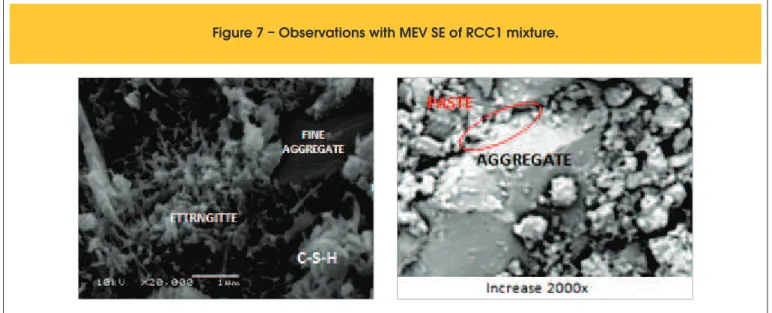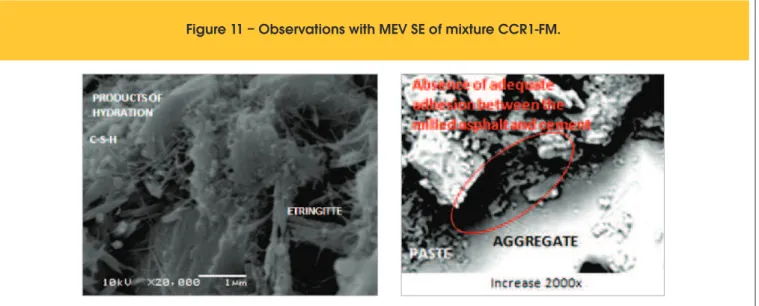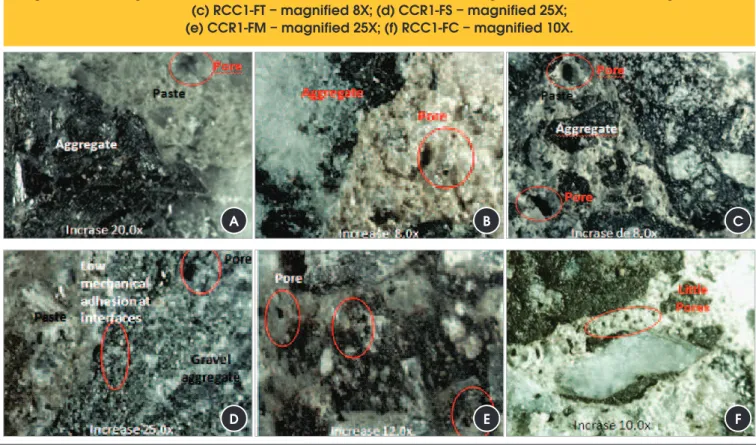Milled asphalt removed from old pavement carpets requires tenable handling easily reachable through its incorporation within other paving materi-als. This work deals with the effects of such incorporation to dry compacted concretes. Fine, intermediate, coarse and whole portions of milled asphalts were blended to a reference concrete. Mechanical tests disclosed remarkable losses on its strengths and modulus of elasticity; for the stereoscope and scanning microscopy pointed out impaired transition zones between the cement paste and the milled aggregates involved by
thin asphalt ilms. Nevertheless, the mechanical results shown that the concretes with incorporated milled asphalt aggregates are suitable for use
in pavement layers as bases and sub-bases even with reduced mechanical parameters.
Keywords: dry concrete, milled asphalt, strength, modulus of elasticity, microscopy, aggregate-paste interface.
Os fresados asfálticos são resultantes da fresagem de revestimentos asfálticos, sendo desejável seu manejo sustentável, o que pode ser alcançado incorporando-os em outros materiais de pavimentação. Neste trabalho foram estudados os efeitos de sua incorporação em con-cretos secos (compactados). Frações de fresados nas faixas de miúdos, pedriscos, britas e sua fração total foram incorporadas ao concreto de referência. Ensaios mecânicos mostraram relevantes perdas de resistência e de módulo de elasticidade desses concretos incorporando fresados. Análises com lupa estereoscópica e microscópio eletrônico de varredura mostraram que a interface entre o agregado fresado e
a pasta de cimento foi prejudicada pela presença do ilme asfáltico envolvendo os fresados. Muito embora a incorporação dos fresados ao
concreto seco reduza a sua resistência bem como outros parâmetros mecânicos, o concreto resultante pode ainda assim pode ser utilizado como base e sub-base de pavimentos.
Palavras-chave: concreto seco, fresados asfálticos, resistência, módulo de elasticidade, microscopia, interface pasta-agregado.
Rendering the loss of strength in dry concretes with
addition of milled asphalt through microscopic analysis
Interpretação da perda de resistência em concretos
secos com incorporação de fresados asfálticos com
apoio de análise microscópica
T. SACHET a tais.sachet@lenc.com.br
J.T. BALBO b jotbalbo@usp.br
F.T. BONSEMBIANTE c
francieli.tiecher@ufrgs.br
a LENC Engenharia Ltda., São Paulo, SP, Brasil
b Universidade de São Paulo, Escola Politécnica, Departamento de Engenharia de Transportes, São Paulo, SP, Brasil
c Fundação de Ciência e Tecnologia do Rio Grande do Sul, Departamento de Materiais de Construção Civil, Porto Alegre, RS, Brasil
Abstract
1. Introduction
The production of milled asphalt (also called reclaimed asphalt pavement, RAP) from restoration of roads and highways, is quite
relevant [1], requiring speciic policies regarding the disposal of
these materials. RAPs are the result of asphalt coating dismantling by milling drums with pins. Its typical features are the presence of
an asphalt ilm involving fractions of aggregates and clumps of par -ticles resulting from the agglomeration of different diameters by as-phalt binder that were not fractionated during its removal by milling. Although in the most technologically developed countries RAP are the basic material for recycling aged asphalt mixtures, there are numer-ous reports on previnumer-ous studies that assessed the consequences of having it included as an alternative application in plastic concretes [2, 3, 4,5], checking its effects in the mixture, given its embedding in
con-crete for paving. Essentially of laboratorial nature, these investigations gave rise to a study on the concretes with the incorporation of RAP, by evaluating mechanical parameters. In all these previous studies, it was found that any amount of milled added to the concrete causes a reduction in its strength and in its modulus of elasticity.
In a previously published study with partial results, the effects of incorporating RAP into dry concrete for paving, usually called by roller compacted concrete [6], were presented. According to the American Concrete Institute [7] the roller compacted concrete (RCC) is a concrete of a very dry consistency, in a way that its den-sity can be easily accomplished by metal rollers. Another peculiar-ity is that in the RCC, the cement consumption is generally lower than that of plastic concrete used in concrete paving. The RCC has a wide application in asphalt pavements and concrete pavements as base, with important advantages over other materials such as
Figure 1 – Grading curves of Pittman & Ragan (1998) and reference RCC
For the preparation of the mixtures, crushed materials (crushed stone size #1- 9.5 to 19 mm-, medium crushed stone – 2.4 to 9.5 mm, and stone dust – less tha 2.4 mm) from the Quarry Cantareira (in São Paulo City), clean river sand and the hydraulic binder CP III-RS-40 (NBR 5735) were used. The kneading water was the drinkable water provided from São Paulo distribution network. The RAP was achieved in the Anchieta Highway, km 39, in the direction to the Coastline of São Paulo State, at the time of its extraction with a milling machine, where Figure 2 shows its particle size distributions before and after extraction of the surrounding asphalt binder. The RAP would be used, of course, without extracting the surrounding asphalt binder and, therefore, with grain distribution tending more to uniformity.
Such RAP were then ranked and separated into three ranges of diameters: big or crushed stone #1 (9.5 to 19 mm), medium or
crushed rock (2.4 to 9.5 mm) and the ine fraction - sand or stone
dust - (with less than 2.4 mm) diameter as shown in Figure 3. The replacement of natural aggregates with RAP was performed as to compose four mixtures as shown in Table 1. The reference RCC is the RCC1; the RCC2 is alternative for employing river sand in
their ine fraction instead of stone dust; mixtures with RAP are des -ignated by RCC1, followed by the abbreviation for the fraction of incorporated RAP (the sand fraction is called FA and so on). cement treated crushed stone and soil-cement mixtures.
Mixtures of RCC incorporating the RAP presented herein were subjected to microscopic analysis through scan electronic micros-copy (SEM) and optics microsmicros-copy, with the purpose of
assess-ing the presence of asphalt ilms over aggregates and damaged
areas of transition, as to elucidate the losses occurring in terms of strength and elasticity modulus in relation to the dry concrete refer-ence used in the study.
2. Types of RCC studied in laboratory
and its constituents
The laboratory investigation on the effects of milled incorporation into the RCC had as a reference the assembly mixtures with par-ticle size distribution according to the recommendations of Pittman and Ragan [8], who studied the aspects related to the shrinkage of these materials, with the purpose of obtaining less retractable mix-tures. This particle size distributions are shown in Figure 1, as up-per, middle and lower band distributions; along with these bands, it is determined the particle size range adopted for the reference mixture, with virgin aggregates and without incorporation of RAP, well graded and tending to the indicated average curve.
Figure
3 – Sieved fractions of RAP: stone dust, medium stone and coarse stone (right to left)
Table 1 – Size distribution of RCC mixtures (by weight)
Mixture
Composition
aggregates (%)
Natural
aggregates (%)
Milled
RCC1
100
100
63
61
76
50
–
–
37
39
24
50
RCC2
RCC1-FS
RCC1-FM
RCC1-FC
RCC1-FT
Reference RCC using stone
dusty or industrial sand
RCC using river sandRCC with 100% of
replacement of fine fraction (<2,4mm) by fine RAP
RCC with 100% of replacement of medium
fraction (2,4 to 9.5 mm) by medium RAP
RCC with 100% of replacement of coarse fraction
(9.5 to 19 mm) by coarse RAP
3. Testing procedures
After the curing process in wet chamber, the specimens were sub-mitted, at 7 and at 35 days of age, to the following mechanical tests: n Diametral compression test or Split test according to the NBR
7222 [9] carried out to determine the indirect tensile strength and modulus of elasticity;
n Bendingor Flexural strength test according to the ASTM-C78-08 [10] carried out to determine the tensile strength in bending and elasticity module to measure the arrow in the middle of the span of joist; the assay was performed with a cleaver.
Microscopic tests, the main object of this article and its discussion, had the purpose of observing the porosity of the concrete, the possi-ble microstructural changes by the presence of RAP, and mainly, the
observation of possible laws in the interface (transition zone) be -tween the milled aggregate with bitumen and cement paste. These observations were made by scanning electron microscopy (SEM), by secondary electrons (SE) and backscattered (BSE), as well as with the use of a stereomicroscope. These tests were performed In order to RCC1 present an indirect tensile strength (ft,sp)of 2.5 N/
mm², previous proportioning studies resulted in cement consumption of 100 kg/m³ [6]. RCC compaction was done in cylindrical molds (100 x 200 mm) and prismatic molds (100 x 100 x 400 mm). For cylindrical
specimens, molding was carried out in ive layers with 24 blows per
layer. In prismatic molds, molding consisted of two compacted layers with 154 strokes each. The compaction energy used was to Normal Proctor with 2.5 kg hammer and drop height of 300 mm (NBR 7182). Tables 2 and 3 show some physical characteristics of the aggregates used in the studies. In Table 4 the compaction indexes for dry
con-crete mixtures studied are given, and the most signiicant moisture
increases were observed for RCC incorporating sand fraction and total fraction; for both cases, there are also more relevant drops in the density of concrete. Anyway, any incorporation of RAP caused a reduction in the density of the mixtures, which is partly explained by the presence of asphalt binders (with unit density).
Table 2 – Virgin aggregates physical indexes
Index
Natural sand
Stone dust
Medium stone
Coarse stone
Maximum diameter (mm)
Fineness modulus
3
Bulk density (kg/cm )
3
Unitarian mass (kg/cm )
4.8
4.018
2,632
1,590
2.4
3.507
2,620
1,630
9.5
6.814
2,708
1,390
19
7.967
2,682
1,430
Table 3 – Physical indexes for the RAP
Index
Coarse
RAP*
RAP*
Fine
Maximum diameter (mm)
Grain apparent
3
density (g/cm )
Absorption (%)
Fineness modulus
19.0
2,288
1.32
0.78
2.4
2,157
–
4.43
* without asphalt extractionTable 4 – Optimum moisture content
for the studied RCC
Concrete
Moisture (%)
a/c ratio
g
as 3(kg/m )
RCC1
RCC2
RCC1-FS
RCC1-FM
RCC1-FC
RCC1-FT
7.15
8.05
8.40
7.30
7.50
8.20
1.137
1.196
1.334
1.159
1.175
1.302
2,268
2,258
2,046
2,130
2,148
2,048
at the Universidade Federal do Rio Grande do Sul (URFGS) at the Laboratório de Cerâmica (LACER) of the UFRGS. A brief description of the equipment and methods are presented in the following. For observation by SEM SE (Secondary Electron), fragments of six samples from the RCC were used. Samples were previously dried in oven and metallized with gold fog. In the observations of secondary electrons, the purpose was to observe the morphology of the samples through their topographic reading. The microscope used for this analysis was a JEOL JSM - 6060 model (Figure 4) that operates between 0.3 to 30 kV, with point image resolution
of 3.5 nm, a magniication range of 18 X at 300,000 X, motorized
goniometric stage of 5 axes, eccentric in all positions, with an tilt of samples from -10 to + 90 º, and 360º rotation.
For analyzes using SEM BSE (Backscattered Electrons), samples were metallized with carbon fog. The microscope used was a JEOL JSM - 5800 model (Figure 4). These samples were obtained by cut-ting specimens to obtain pellets with about 5 mm thickness and 10 mm sides. The images obtained by backscattered electrons show changes in the chemical composition of the features observed, through changes in grayscale. Therefore, it is important that the
pastille is analyzed as lat as possible. This microscope operates in
a range from 0.3 to 30 kV, point image resolution of 3.5 nm,
magnify-ing range of 18 X 300,000 X, a 5-stage-axis motorized goniometric, eccentric in all positions (X = 125 mm , Y = 100mm, Z = 43 mm),
sample tilting from -10 º to + 90 º and 360 º rotation, a vacuum pre-chamber, and with the possibility of having a qualitative chemical analysis through spectroscopy and dispersive energy (EDS).
The observations made in the stereoscopic magnifying glass
Olympus BX51M (Figure 5), were performed to assess the poros -ity of the samples and the bond between the cement paste and the milled aggregate surfaces.
4. Results presentation and its analysis
4.1 Mechanical tests
Indirect tensile strength (fct,sp) of concretes is showed in Table 5
(for all results the mean values, standard deviation and coefi
-cient of variation are shown), where their speciic gravities are
also indicated. The decreasing in the values of the density of the mixtures with RAP is evident in the results, where the concrete
incorporating ine or total RAP fractions had the greatest reduc -tions. Reduction in fct,sp was very important for RAP sand fraction incorporation, reaching an average over 60%; full RAP fraction incorporation, in turn, had more than 50% reduction. Indirect ten-sile strength was in all cases fairly affected. Results show to be consistent with the compaction moistures that were higher for RCC1-FS and RCC1-FT.
It is important to point out that signiicant differences were observed in
the way samples had ruptures when incorporation of RAP was present. Concrete with no milled had abrupt and conical type fractures, with cylin-der splitting, characterized by the disruption of the mortar. The samples with RAP had more subtle fractures; cylinders were not split and they kept on having some charge after the initial fracture (Figure 6). The
ex-Figure 5 – Observations in a stereomicroscope Olympus BX51M
Table 5 – Values for indirect tensile strength of RCC
Concrete
n
Age (days)
g
(kg/m )
3planation for this is the energy dissipation capacity of the concrete with asphalt milled, with a more ductile interface, and a more gradual way. It is important to emphasize that these dry concrete with milled incorporation show fracture strength and fracture energy by area of lower propagation, as seen with the same concrete concerned by Sachet et al.[11].
Test results for lexural strength (fct,f)are shown in Table 6 with the appropriate statistics already mentioned. During the tests, it was observed the presence of lumps in the mixture, from the union of
coarse and ine grains with asphalt binder. Of course, such bind
-ing weaken the concrete; these lumps cause a heterogeneous distribution of aggregates in the mixture, which can also promote the emergence of more fragile areas. It is observed that the fct,f value (tests using one cleaver) is practically twice the value of fct,sp. Strength dropping was not equal for all concretes with different fractions of milled incorporated; sand and medium fractions re-sulted in lower decrease in the value of fct,f while coarse fractions or
the total fraction cause signiicant decreases in strength; therefore,
there is no relation to the results observed for fct,sp.
Figure 6 – Indirect tensile tests on RCC1 (left picture – abrupt fracture)
and RCC-RAP (central and right picture– more subtle fractures)
Table 6 – Flexural strength results for RCC
Concrete
n
Age (days)
3g
apparent(kg/m )
f (MPa)
ct,fsd (MPa)
cv (%)
D
f (%)
ct,fRCC1
RCC1
RCC2
RCC2
RCC1-FS
RCC1-FM
RCC1-FC
RCC1-FT
3
6
3
6
6
6
6
6
7
35
7
35
35
35
35
35
2,446
2,321
2,347
2,292
2,269
2,296
2,300
2,164
2.31
4.23
2.18
3.91
3.78
3.80
2.37
2.55
0.04
0.32
0.02
0.24
0.10
0.32
0.31
0.21
1.7
8.7
1.1
6.2
2.9
8.9
11.6
8.6
–
–
-5.6
-7.6
-10.6
-10.2
-44.0
-39.7
Table 7 – Modulus of elasticity of RCC in tensile.
Concrete
n
Age (days)
E (MPa)
spsd (MPa)
cv (%)
D
E (%)
spValues of elasticity modulus of concrete containing RAP had
sig-niicant decrease, as can be seen in Tables 7 and 8. At irst, these
reductions can be due to a greater amount of voids in concrete with
heterogeneity and milled. These heterogeneities are conigured in a
weakening of the interface binding paste/milled aggregated, as well
as in the presence of very lexible lumps in relation to its surround -ings, and not adhered, which could be seen as voids in the internal structure of the concrete; it should also be understood that the
coef-icients of variation for this parameter indicate a reasonable disper
-sion in the results in most cases. The most signiicant declines are
observed in the elasticity modulus measured during tests of diamet-rical compression with the stress curves versus strain. In all cases, concrete with total milled fraction incorporation were the most af-fected in relation to the reduction in the values of elasticity modulus. By making comparative judgments, the elasticity modulus values
obtained with the incorporation of milled are indicative of a signii -cant loss of a degree of freedom of materials; they start to behave, in values, as cement treated crushed stones, or even as soil-ce-ment; even then, they can still be considered advantageous in rela-tion to the paving materials aforemenrela-tioned, because they have a higher strength, which ensures lower ratios of elasticity modulus/
strength. This is an indicative that alternatives of paving using RCC with RAP fractions in relation to traditional cement bases are real.
4.2 Interpretation of microscopic analysis
4.2.1 Scanning electron microscopy (SE and BSE)
The SEM was performed on all six mixtures studied. As expected, MEV analysis enabled to observe the transition zone between the cement aggregate and paste. Images obtained by the SEM SE of the RCC samples show the presence of characteristics forma-tions of ettringite and other hydration products, pointing out that the hydration reactions actually occurred in the concrete containing RAP aggregates (Figure 7). However, due to the limitations of this analysis, it was possible to estimate that the amount of ettringite formed as equivalent to all concrete.
In Figure 7, it can be seen that the RCC1 concrete paste is dense and no homogeneous, and the mortar volume was not enough to involve the grains; it is typical of compacted concretes with low cement content. It was observed in this mixture the formation of hydrating products, CSH (calcium silicate hydrate) and ettringite.
Table 8 – Flexural modulus of elasticity of RCC.
Concrete
n
Idade
(dias)
E
f1(MPa)*
(MPa)
sd
(%)
cv
D
(%)
E
f1D
E
f2(%)
E
f2(MPa)**
(MPa)
sd
(%)
cv
CCR1
CCR2
CCR1-FS
CCR1-FM
CCR1-FC
CCR1-FT
6
6
6
5
5
6
35
35
35
35
35
35
24,313
27,540
13,394
12,132
10,416
7,972
3,494
6,126
3,216
1,186
922
1,453
14.4
22.2
24.0
17.1
8.9
18.2
–
13.3
-44.9
-50.1
-57.2
-67.2
–
9.5
-37.5
-34.6
-51.4
-54.5
28,632
31,357
17,888
18,725
13,925
13,017
4,373
5,779
5,594
1,630
2,402
3,426
15.3
18.4
31.3
12.4
21.3
26.3
*E by Möhr analogy; **E by stress-strain diagramf1 f22
Observations on SEM BSE enabled to view some important as-pects in the transition zone between the cement paste and the aggregates (Figure 8). Apparently, in all mixtures, there is a failure
tendency in the binding between cement paste and aggregate; it stands on concrete RAP aggregates. Figure 8 also shows that in
the RCC2, the amount of paste was also insuficient to involve the
Figure
8 – Observations with MEV SE of the RCC2 mixture.
Figure 9 – Observations with MEV SE of mixture RCC1-FT
4.2.2 Stereoscopic magniier observations
Observations by stereomicroscopy (Figures 13) showed no dif-ferences between the samples of concrete produced with natural aggregates (RCC1 and RCC2) and those produced with RAP ag-gregates. However, in a qualitative analysis, the images show to occur a better bind between natural aggregates and cement paste, i.e., the lower strength of milled aggregates of the concrete may be related to low mechanical adhesion of the RAP particles of the cement matrix. Therefore, it is believed that, with the increase in water/cement ratio (or moisture) of RCC with RAP incorporation, the low mechanical adhesion at interfaces is one of the causes, perhaps the most important, which contributed to the concrete with RAP aggregate have presented lower resistance values.
5. Conclusions
The laboratory study to evaluate the properties of compacted dry concretes (RCC) with RAP incorporation, enabled to achieve the following conclusions:
n RCC with RAP increased w/c ratio when compared to the ref-aggregates. It was possible to observe the existence of a large
amount of typical air voids incorporated.
In the RCC1, it can be observed products of hydration, for exam-ple, the CSH. More importantly, it was found that this mixture is not homogeneous or dense (Figure 9). The images enabled to view microcracks in the transition zone between RAP aggregate and cement paste.
In Figure 10, which presents images of RCC1-FS mixture, the presence of entrained air with pore shrinkage cracks and forma-tion of C3S (tricalcium silicate), one of those responsible for the mixture strength. Microcracks were also observed in the transition zone between cement aggregates and paste.
In the micrographs of the RCC1-FM mixture, the presence of a het-erogeneous paste is evident, as well as the formation of calcium monosulfoaluminate and CSH (Figure 11). Porosity is an important characteristic of this concrete, where the absence of adequate ad-hesion between the RAP and cement paste was observed. The lack of adhesion is also visible in the RCC1-FC mixture (Figure
12). Calcium salts were identiied in this case; the transition zone
observed was not very dense, indicating a weaker region resulting in a concrete with less strength.
Figure 11 – Observations with MEV SE of mixture CCR1-FM.
tion of the interface between the paste and RAP aggregate. Adhesion failures were evident in that zone; the observations showed that for the dry concrete the amount of paste is not enough to involve the aggregates (low-mortar level);
n The RCC2 concrete (river sand) showed higher porosity com-pared to RCC1 (with industrial sand), but both have had better quality of bond between aggregate and cement paste;
n In the present RCC1-FM concrete, it was observed during the analysis with SEM, the presence of pores with rounded shapes, caused by the presence of trapped air in the mixture; in addition, the RAP aggregate was not broken with the
rup-ture of the specimen, which was relected in the results of ten -sile strength and modulus of elasticity: both parameters were higher for the mixture;
n The microstructural features observed for RCC1-FC are the presence of large and rounded pores and coarse aggregates with relief, which allows concluding that the rupture was given in the cement paste and not in the aggregate.
n Microscopic analyzes allowed to observe largest concrete po-rosity in the RCC1-FS, which was consistent with the higher moisture content observed.
As for the mechanical results observed, it can be conclude that,
although the speciic RAP incorporations decreased the strength of
the dry concrete, affecting all mechanical parameters, and appar-ently increasing the porosity of the mixtures. Still, this is a material
which can be used as sub-base and base loor (underneath layers
of concrete or asphalt pavements) compared to other traditional materials such as cement treated crushed stone, because their erence concrete. This increase was caused by the
imperme-ability of the milled aggregates surface due to the presence of
asphalt ilm around them. The concrete that showed higher w/c
was the RCC1-FS (incorporating the milled fraction in the sand range), followed by RCC1-FT (with total fraction incorporation), which resulted in more porous samples. Therefore, there is a
clear suspicion that the presence of milled ine fraction requires
higher content of water for compaction; once maintained the cement consumption, there is a drop of strength;
n Any of the dry concrete (studied) incorporating RAP have
expressive reduction in both indirect tensile and lexural
strength and, regardless of the amount and particle size of the RAP band, accompanied of decrease in values of modu-lus of elasticity;
n The concrete with total RAP fraction incorporated was the most affected one in relation to the reduction in the values of modulus of elasticity;
In the milled concrete incorporation, rupture was visibly differenti-ated, and the specimens do not split immediately after the peak load to the rupture; conversely, the concrete without RAP frac-tured more abruptly at the maximum load of rupture;
n According to microscopic analysis, the RAP-RCC concrete fea-tures are more empty, a fact that apparently interfered with the
decrease in speciic weight values;
n Microscopic observations revealed that even with RAP aggre-gates, there was clear formation of the hydration products of Portland cement in the RCC mixtures;
n SEM images were important because it allowed the
observa-Figure 13 – Micrographs obtained by stereomicroscopy. (a) RCC1 – magnified 20X; (b) RCC2 – magnified 8X;
(c) RCC1-FT – magnified 8X; (d) CCR1-FS – magnified 25X;
(e) CCR1-FM – magnified 25X; (f) RCC1-FC – magnified 10X.
A
D
B
E
C
properties are even better compared to others. This conclusion is
signiicant because the results of the study show that the incorpo -ration of RAP to prepare RCC bases is quite feasible, and that, also, the resulting material is of higher quality than other conven-tional materials for pavement bases. Finally, it is shown a possibil-ity of sustainable management of milling products with its use in the preparation of dry concretes.
6. Acknowledgements
The main and middle authors have had their project sponsored
by the National Council of Scientiic and Technological Develop -ment (CNPq-MCT-Brazil) through process 473498/06-5. Authors are grateful to the Eletronic Microscopy Center (CME) as well as to the Pottery Laboratory (LACER) of the Federal University of Rio Grande do Sul at Porto Alegre for the given support to the micro-scopic analysis.
7. References
[01] FEDERAL HIGHWAY ADMINISTRATION. Reclaimed
Asphalt Pavement. Disponível em:
<http://www.tfhrc.gov/hnr20/recycle/waste/rap131.htm>. Acesso em 03/07/2009.
[02] DELWAR, M., FAHMY, M., TAHA, R. Use of reclaimed
asphalt pavement as an aggregate in Portland cement concrete. ACI Materials Journal, v. 94, 3, 1997, p.251-256.
[03] HUANG, B., SHU, X., LI, G. Laboratory investigation
of Portland cement concrete containing recycled asphalt pavements. Cement and Concrete Research, 35, 2005, p.2008-2013.
[04] HUANG, B., SHU, X., BURDET, E., G. Mechanical
properties of concrete containing recycled asphalt pavements. Magazine of Concrete Research, 58 (5), 2006, p.313-320.
[05] HOSSINEY, N., WANG, G., TIA, M., BERGIN, M. J.
Evaluation of concrete containing RAP for use in concrete pavement. Proceedings of the Transportation Research Board Annual Meeting (Cdrom), Transportation Research Board, Washington, D.C., 2008, 13 p.
[06] SACHET, T.; BALBO. J.T.; PINTO, P.C.; MUGAYAR,
A.N.; ALBUQUERQUE, M.C.F. Incorporação de fresado asfáltico em concreto compactado com rolo.
Proceedings of the 51th Brazilian Concrete Conference (Cdrom), IBRACON, 2009, Curitiba.
[07] AMERICAN CONCRETE INSTITUTE. Roller Compacted Concrete - Authorized Reprint form Concrete International: Design and Construction. v.9, 2, 1987, 55p.
[08] PITTMAN, D. W., RAGAN, S. A. Drying shrinkage of roller-compacted concrete for pavement applications. ACI Materials Journal, vol. 95, 1, 1998, p.19-26. [09] ASSOCIAÇÃO BRASILEIRA DE NORMAS TÉCNICAS.
NBR7222: Argamassa e concreto – Determinação da resistência à tração por compressão diametral de corpos-de-prova cilíndricos. Rio de Janeiro, 1994, 3p.
[10] AMERICAN SOCIETY FOR TESTING OF MATERIALS.
C78-08: Standard Test Method for Flexural Strength
of Concrete (Using Simple Beam with Third-Point Loading), 2008.
